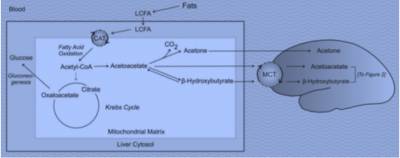
If you are on a healthy eating plan based on the current macronutrient portioning of food per day you are probably eating 2,000- 2,200 Kcalories if you are a female and approximately 2,600-2,800 Kcalories if you are a male.
The food pyramid emphasises that our break up of Kcalories should be 50% carbohydrate, 25% fats and 25% protein. As a 78 kilograms male, I should be eating approximately 2,700 Kcalories divided up into approximately 675 kcals of protein and fat and 1,350 Kcalories of carbohydrate per day. Being active, this prescription should keep me weight stable.
Caloric Restricted Weight Loss
If I was looking for weight loss and was prescribed a caloric restricted diet of 1,200 Kcalories, my division of macronutrients would be 600 Kcal of carbohydrate, 300 kcals of fat and protein. The 600 kcals of carbohydrate prescribed is enough to maintain my normal bodily functions at rest but is just barely enough to feed my brain as well if I have previously been on a high carbohydrate diet.
My Liver is pumping hard making any additional required glucose via converting some protein to glucose (gluconeogenesis). The protein conversion is only good for approximately an additional 200 Kcals so all in all I have approximately 800 Kcals of carbohydrate available for my 24 hours cycle. So at this point all is good and I am coping well.
My background in intensity had always been to“go hard or go home”.
My motto used to be “just do it…. and then spew it!”
As I have aged I have reviewed my old philosophy and realised the importance of multiple movement experiences, performed at low to moderate intensity for as much of the day as possible. What if I went back to my old ways and incorporated some high intensity exercise as part of my weight loss intervention in combination with my reduced 1,200 kcals diet?
Off and Running…
I am now on the treadmill running at 10 kilometres per hour. At this pace approximately 60% of my fuel will come from carbohydrates. Within the hour on the treadmill running at 10 kph I have used approximately 300 kcals of carbohydrates. In the 24 hours that incorporated this run I had 600 kcals of carbohydrate available for all the body systems to function at rest as well as an additional 200 Kcals that can be converted from protein to carbohydrates, so in total 800 kcals of carbohydrate.
My brain requires approximately 30% of my available carbohydrates, which translates into approximately 240 Kcals of energy (30% of 800 Kcalories).
If I expend 300 kcals of carbohydrates from my run, 600 kcals for the cells of the body (brain included) to perform their daily functions, I will have exceeded my total concentration of carbohydrates (600 + 200 = 800 Kcalories) for the day by 100 Kcals.
All of a sudden……“Houston we have a problem”.
If I run on the treadmill 3 days per week with a recovery day between each run, my body will adjust by storing more glycogen that can be used on the run days and I will be able to cope with the reduced carbohydrates available.
But what if I decided to run at this pace for 5 to 7 days of the week. After a week of this combination I could begin to feel tired, physically fatigue or as it has been described… “hit the wall”.
“Hitting the wall” is not restricted to just those who run marathons.
People on severe caloric restricted eating plans combined with high intensity exercise can also experience a similar feeling. I am now in the zone of Glycogen depletion. This can only get worse unless I take some time to recover between training sessions or eat more dietary carbohydrate, energy bars or energy drinks to quickly increase my blood sugar levels and thereby increase my Kcalories….. but this would be against the philosophy of our weight loss program.
The most obvious alternatives would be to:
-
Reduce the intensity of the training dose and expend the same number of Kcalories over a longer period of time tapping into my fat stores and preserving the limited carbohydrates stores for other functions.
-
Alternate high intensity days (glycogen dependent days) with much lower intensity days (fat dependent days).
-
Eat more carbohydrates with the intention of exercising at a high intensity every day.
-
Limit high intensity days to three times per week with at least a 24 hours recovery between training sessions and on the other days perform 10,000 steps or additional movement in the home, at work, active transport at an intensity between 2-6 METS (low to moderate).
What about limiting my carbohydrate intake?
A recent alternative recommendation is to limit our carbohydrate intake to 50 grams per day for two weeks, which will teach our body to utilise more of our fat stores.This method would require a rethink of the proportions of our macronutrients.
What if we changed our 1200 kcalories diet to include 30% protein, 20% carbohydrates and 50% of good fat?
The theory behind this would be that after a two weeks period of no intense exercise our body will begin to convert ketones from our fatty acids for energy to within an acceptable limit, which could potentially improve our fat loss. Ketones could potentially now provide approximately 50% of the brain’s fuel taking the pressure of it being fully carbohydrate dependent.
Additionally, the skeletal muscles would be better adapted to metabolise fatty acids sparing the additional glycogen and protein that was previously used a fuel. The accompanying exercise prescription would involve low to moderate intensity activities of daily living, of which walking would be the cornerstone. Remember we have potentially 80,000 Kcals of energy available for fuel from fat compared to 2,000 Kcals of carbohydrate…. so why not try and use it. This theory tips the carbohydrate loading theory of performance on its head! Think about it as it could have merit in everything we do from weight loss, improvements in health and athletic performance.
Arthur C Clarke once said “I don’t pretend to have all the answers. But the questions are certainly worth thinking about”.
Dr Paul Batman




